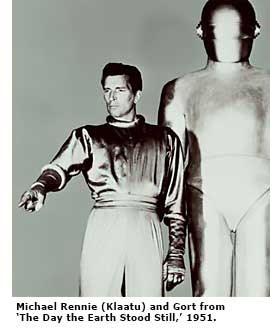From Russia with Modernism: Theremin - Page 4
Theremin's last forays into research sought, among other things, the perpetuation of male potency and of life itself. Before he could finish, Theremin passed away in November 1993. But his contributions to music and imagination were sustained, partly through Martin's documentary, which, together with a lively collection of websites and blogs, helped launch a new generation of would-be thereminists into the New Millennium.
Among them is Robby Virus, a one-time student cellist whose stage name was based on his day job as a molecular biologist for a biotech company, and former rock and jazz bassist Pamelia Kurstin. Virus ordered an instrument from Moog, which arrived with an instructional video featuring Lydia Kavina, whom Virus later encountered at one of the international theremin festivals, begun in 1997.

For Kurstin, "It was because of how beautifully [Clara Rockmore] played it [in the film] that I was attracted to the instrument," she says. "If I'd heard anyone else playing it, I might not have heard the potential of the instrument, how beautiful and vocal it could sound."
Kurstin, an expatriate American living in Vienna, is known both for pushing beyond musical convention and for intoning bass lines as she accompanies other instruments, with her theremin set to a lower musical register.
After Brian Wilson, a handful of rock artists made use of the theremin, among them Jimmy Page (on Led Zeppelin's 'Whole Lotta Love'), Brian Jones (on the Rolling Stones' 'Please Go Home,' and Lothar and the Hand People. Many others followed. "The pop musicians were particularly important here, because they were always looking for new effects and new instruments," says Kavina.
Virus and the founders of Project: Pimento decided to go retro, choosing what they thought of as a mid-century name for what they claim is 'the world's only theremin lounge band.' "We wanted something for a cocktail lounge, on one hand, and on the other hand sort of a '60s sense of government spies, secret agents, a 'Man From U.N.C.L.E.' kind of thing," he says.
With his band now in demand at 'tiki festivals' and other gatherings of fans of lounge music and exotica, as well as at clubs and restaurants, Virus has learned to adjust the placement and settings of his theremin to avoid letting the electromagnetism of the venue and the crowd distort his 'pitch field.' "You can't be a perfectionist, and you can't be a prima donna—you've gotta go with the flow," he advises.

Kavina, in her concerts and recordings, mixes in classical pieces with contemporary creations, including her own. She also occasionally plays with a Russian experimental surf band, and as a featured part of the visionary theater pieces of Robert Wilson.
Kavina enjoys the challenge, and points out that "new techniques have to be discovered with each new composition," including those created by composers with indications of shapes or hand positions instead of standard musical notation. "Each small movement makes a change of the sound, and the audience can very well see this," she points out.
Aside from her DVD instructional video, Kavina is sought after for personal lessons, and her accomplished students have included Germany's Carolina Eyck and Japan's Masami Takeuchi, both known for their precise intonation. The same degree of precision, alongside interpretive sensitivity, is applied to a broad repertoire, ranging from pop to classical, by Peter Pringle, younger brother of Canadian pop singer Anne Murray.
But eight decades after it enchanted the father of the proletarian revolution and some of the titans of American capitalism, the theremin and its growing number of virtuosi continue to stand apart as alluring aliens, eager for understanding and validation. Indeed, the theremin is an instrument still ahead of its time.
Photos: Jim Ferreira; and courtesy Mickey McGowan of the Unknown Museum, Project: Pimento, Lydia Kavina, Valerio Saggini, University of Maryland's Special Collections (Clara Rockmore Collection), Charles Richard Lester
• Discover more about the theremin and the fascinating world around it at Valerio Saggini's Thereminvox website.
THEREMIN ESSENTIALS

1. Clara Rockmore: Lost Theremin Album (Bridge); The Art of the Theremin (Delos)
Achieving near-perfect pitch and sensitive interpretation of a mostly classical repertoire, the late Rockmore raised the bar of theremin playing as high as it could go on both albums. She's accompanied mostly on piano, by her sister Nadia.




